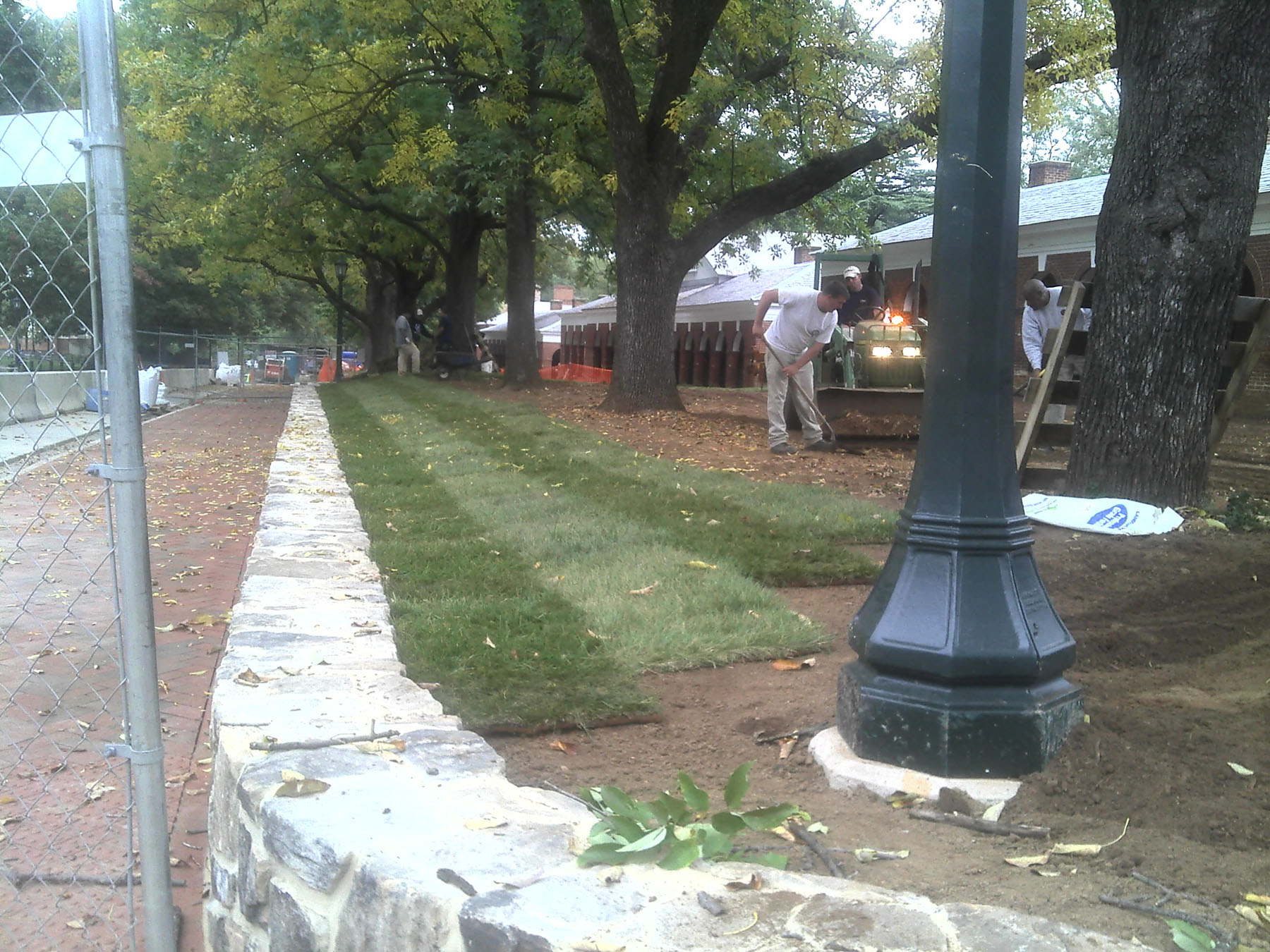November 29, 2011 — The West Range at the University of Virginia has a new look – with better pedestrian access and drainage, new erosion control measures and stately stone walls defining the grass along the east side of McCormick Road.
The project expanded the sidewalk from six feet wide to eight feet, with the additional two feet coming from McCormick Road.
"The sidewalk was too narrow," said Richard M. Hopkins, landscape superintendent for Facilities Management. "Because the sidewalk was narrow, the students were forced to walk on the edge of the bank and we couldn't get grass to survive there."
The bank no longer slopes, and the soil under the tall fescue grass is held firmly in place by concrete retaining walls with stone facings.
"We wanted a fieldstone in a variety of colors," said project manager James Zehmer of Facilities Management. "Someone told me 'It looks as if it has been there forever,' which is good because we did not want it to stand out. We wanted it to blend into the landscape."
The walls, which vary in height from about 12 to nearly 30 inches, now define the edge of the grass and keep erosion in check. The grassy area between the West Range rooms and McCormick Road suffered considerable erosion, not just from people walking on the hillside, but also from water running off the roof of the West Range that etched deep gullies in the ground along the roof's drip line.
To remedy this, trenches 18 inches deep and wide were dug along the drip line and porous pipe laid at the bottom, which then was covered with gravel and a layer of decorative pea stone. The pipes divert the water runoff directly into the storm drains.
The work also included new curb cuts for the sidewalks and paving portions of the alleys.
The project did disrupt the quiet along the West Range.
"There is a beneficial aspect to the walls – there is improved landscape and drainage and it makes the University more attractive," Range resident Jack Thorman said. "But many Range residents were not happy the project went on so long."
Zehmer, who noted the project came in on time and under its $990,000 budget, said that workers made an effort to get the most disruptive parts of the work completed before the students returned in the fall.
"This caused a lot of headaches for the students and faculty on the West Range and we appreciate their patience," Zehmer said. "We worked with them and we were able to open some sections earlier than we thought."
Now that the project is completed, Zehmer is pleased that it is blending into everyday life at the University.
"I saw some students sitting on the wall eating lunch and that felt good because they are using the space," he said.
The project expanded the sidewalk from six feet wide to eight feet, with the additional two feet coming from McCormick Road.
"The sidewalk was too narrow," said Richard M. Hopkins, landscape superintendent for Facilities Management. "Because the sidewalk was narrow, the students were forced to walk on the edge of the bank and we couldn't get grass to survive there."
The bank no longer slopes, and the soil under the tall fescue grass is held firmly in place by concrete retaining walls with stone facings.
"We wanted a fieldstone in a variety of colors," said project manager James Zehmer of Facilities Management. "Someone told me 'It looks as if it has been there forever,' which is good because we did not want it to stand out. We wanted it to blend into the landscape."
The walls, which vary in height from about 12 to nearly 30 inches, now define the edge of the grass and keep erosion in check. The grassy area between the West Range rooms and McCormick Road suffered considerable erosion, not just from people walking on the hillside, but also from water running off the roof of the West Range that etched deep gullies in the ground along the roof's drip line.
To remedy this, trenches 18 inches deep and wide were dug along the drip line and porous pipe laid at the bottom, which then was covered with gravel and a layer of decorative pea stone. The pipes divert the water runoff directly into the storm drains.
The work also included new curb cuts for the sidewalks and paving portions of the alleys.
The project did disrupt the quiet along the West Range.
"There is a beneficial aspect to the walls – there is improved landscape and drainage and it makes the University more attractive," Range resident Jack Thorman said. "But many Range residents were not happy the project went on so long."
Zehmer, who noted the project came in on time and under its $990,000 budget, said that workers made an effort to get the most disruptive parts of the work completed before the students returned in the fall.
"This caused a lot of headaches for the students and faculty on the West Range and we appreciate their patience," Zehmer said. "We worked with them and we were able to open some sections earlier than we thought."
Now that the project is completed, Zehmer is pleased that it is blending into everyday life at the University.
"I saw some students sitting on the wall eating lunch and that felt good because they are using the space," he said.
— By Matt Kelly
Media Contact
Article Information
November 29, 2011
/content/uvas-west-range-landscaping-refurbished

